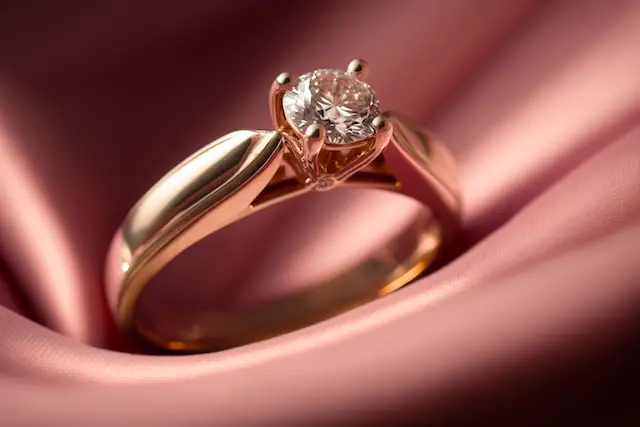Engagement Ring Metals Pros and Cons
Looking for the perfect engagement ring can be overwhelming, especially when choosing the right metal.
With so many options available, it’s important to weigh the pros and cons of each metal type before making a decision.
From classic gold to trendy rose gold and durable platinum, each metal has unique features that make it a great choice for an engagement ring.
Importance of choosing the right engagement ring metal
Choosing the right engagement ring metal is important for a few reasons.
First and foremost, it can impact the ring’s durability over time. Different metals have varying levels of hardness and resistance to wear and tear, so selecting a metal that can withstand daily wear is crucial.
Additionally, the type of metal used can affect the overall appearance and style of the ring. Some metals may complement certain gemstones or settings better than others, so it’s important to consider your personal preferences and style when deciding.
Lastly, engagement rings are often sentimental pieces that are meant to be worn for a lifetime – choosing a metal that you love and personalizing your engagement ring that will stand the test of time is key in creating a meaningful symbol of your love and commitment.
A brief overview of popular engagement ring metals
Before going into the Pros and Cons, let’s take a quick look at the most popular metals.
Gold is a classic choice in various colors, including yellow, white, and rose gold. It’s durable, easy to work with, and has been used in jewelry-making for centuries.
Platinum – One of the strongest and most durable metals available for jewelry-making. It has a natural white color that won’t fade or tarnish over time.
Palladium – Similar to platinum in appearance and durability, but at a lower price point.
Titanium – Extremely strong and lightweight, making it an excellent option for those with an active lifestyle or who work with their hands frequently.
Rose Gold – A trendy choice that has become increasingly popular in recent years due to its warm, romantic hue.
Sterling Silver – A budget-friendly option that can mimic the look of more expensive metals like platinum or white gold.
Cobalt Chrome – Durable, hypoallergenic, and scratch-resistant.
Tungsten Carbide – Very strong and durable, making it an excellent choice for the active bride.
Zirconium – A stylish alternative to standard metals, with a unique black color that won’t fade or tarnish.

Gold: Pros and Cons
Pros
Gold is the way to go if you’re looking for a classic style that never goes out of fashion. Not only does it have a timeless feel, but its durability means that it will last you and your partner many years into the future! Plus, with yellow, white, rose (or pink), and green gold available as options, there are plenty of color choices to find something that fits your taste and budget.
- A classic and timeless look.
- Durable and long-lasting.
- Versatile in terms of color options.
Cons
One downside to gold is that it can be expensive, depending on what type you choose.
Furthermore, 18-karat gold is softer and more susceptible to scratches compared to 14-karat gold or other resilient metals such as platinum or titanium. As such, it does not provide the same level of longevity for jewelry pieces. So if you want a ring that looks good over time without needing too much maintenance or touch-ups, gold may not be the best option.
- It can be expensive.
- Not as scratch-resistant as other metals.
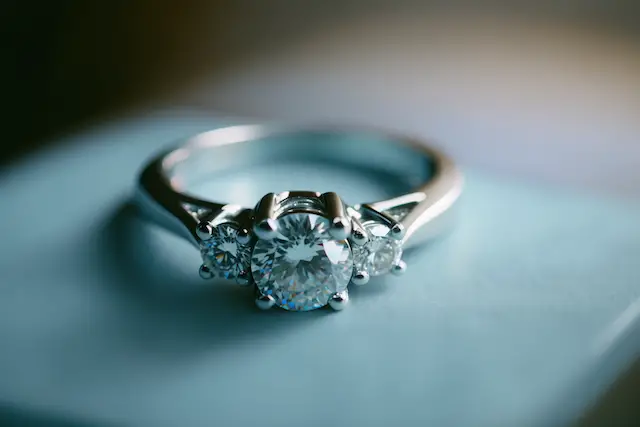
Platinum: Pros and Cons
Pros
One of the significant benefits of platinum is its strength and durability. It is one of the strongest metals in existence and is much more durable than gold or silver. This means that if you choose a platinum band for your engagement ring, it will last a long time without losing its shape or color.
Additionally, since platinum is hypoallergenic and doesn’t corrode, there are no worries about skin irritation from wearing it or having it tarnish over time.
Platinum also looks great with diamond rings because of its bright white color, which emphasizes the sparkle and brilliance of the diamonds on the ring. Many jewelers prefer setting diamonds in platinum bands since they believe that the metal brings out the beauty of the gemstone better than any other metal can.
In addition, since platinum is denser than gold, it requires less metal, so you can get a larger stone without needing a weighted setting.
- Extremely durable and long-lasting.
- Naturally, white in color, so it won’t fade or tarnish over time.
- Hypoallergenic, making it a good option for those with sensitive skin.
Cons
One of the cons to selecting a platinum band for your engagement ring is its price tag; it’s much more expensive than gold or silver bands due to its rarity and strength. That said, if you look hard enough, you may be able to find some more affordable options on sites like Etsy or eBay—make sure you read reviews carefully before buying!
Additionally, some brides don’t like how “hard” platinum looks on their fingers; they feel like they can’t show off their diamond ring as well if it’s set in a plain-looking metal band instead of something more ornate like gold or silver.
High-polished platinum will show scratches over time and may need to be repolished more frequently, which is an additional cost.
- More expensive than other metals.
- It can show scratches more quickly than other metals.
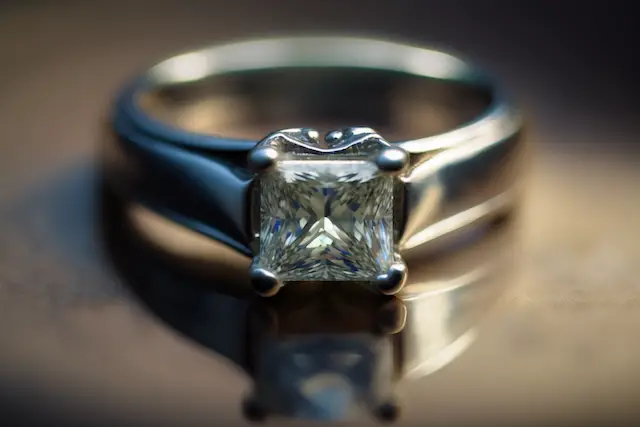
Palladium: Pros and Cons
Pros
Palladium is a precious metal that looks much like platinum but has some distinct advantages. It’s also hypoallergenic, so it won’t irritate sensitive skin like some other metals can.
Additionally, palladium is resistant to tarnishing and corrosion—so your ring will look as good as new for years to come! Finally, palladium rings are strong and lightweight, perfect for couples who enjoy active lifestyles.
- Durable but lightweight.
- Works with all gemstones.
- Hypoallergenic and ideal for those with delicate skin.
Cons
Because it’s not as widely used as gold or platinum, there may be fewer design options available than with those metals. In addition, due to its rarity in comparison to other precious metals, finding replacement parts can be difficult if needed in the future due to damage over time.
Although palladium is typically regarded as lightweight, some individuals may find this unsatisfactory compared to platinum’s weight.
Investing in palladium jewelry may be tempting, but it’s relatively new to the market, so its long-term value is uncertain.
- Limited availability at traditional jewelry stores.
- Less prestigious than platinum.
- Palladium is more expensive than platinum or gold.

Titanium: Pros and Cons
Pros
Titanium is incredibly durable, making it an ideal choice for those looking for a long-lasting metal for their engagement ring.
It is also lightweight, making it comfortable to wear on your finger all day. And because titanium is so strong, you won’t have to worry about the prongs or settings becoming loose or damaged over time.
Plus, since titanium is so strong, it can hold up against everyday wear and tear without getting scratched or dinged up, as some softer metals like gold or silver can.
- Very strong and durable.
- Lightweight and comfortable to wear.
- Available in different colors.
Cons
One of the key drawbacks of titanium is that it cannot be resized as easily or cost-effectively as other metals such as gold or silver can, which means you will have to find a specialist jeweler who has the ability and expertise to do so.
If your finger size changes over time (often due to weight gain/loss), you may need to buy a new ring instead of just having it resized by your jeweler.
Additionally, suppose the ring needs repair work done down the line (such as replacing prongs or settings). In that case, it will likely cost more than other metals since working with titanium requires specialized tools and knowledge not all jewelers possess.
Finally, while titanium comes in several different finishes, it is not quite as shiny as other metals (such as white gold). So if you’re looking for something with more sparkle, titanium may not be the ideal choice.
- Not easily resizable if needed.
- It can be difficult to engrave.
- Repairs and maintenance can be costlier than other metals.
- Not as shiny or sparkly as some other metals.

Rose Gold: Pros and Cons
Pros
Its beauty is the most obvious advantage of opting for a rose gold engagement ring.
The unique hue pairs well with almost any skin tone, making it an excellent choice for all brides-to-be.
Additionally, rose gold tends to be more affordable than white or yellow gold, as it is made from a combination of copper and other metals rather than pure gold. This means that you can get a stunning piece without breaking the bank!
Rose gold also has several advantages over other metals when it comes to durability. It is harder than yellow or yellow gold, meaning it is less likely to scratch or dent over time. In addition, its warm hue never fades, even after years of wear and tear—so you can rest assured that your ring will always look as good as new!
- Unique and trendy look.
- Warm, romantic color.
- Complements all skin tones.
Cons
As lovely as they may be, there are some drawbacks to choosing a rose gold engagement ring over one made from another metal. One con is that the metal is softer than other types of precious metals, such as platinum or white gold—which means that it may need more frequent cleaning to stay looking its best.
Additionally, because the metal contains copper, it can sometimes cause allergic reactions in some people if they are sensitive or have allergies—so make sure to check with your jeweler before making any final decisions!
- It can be more expensive than other gold options.
- Not as durable as other metals.
- Not hypoallergenic.
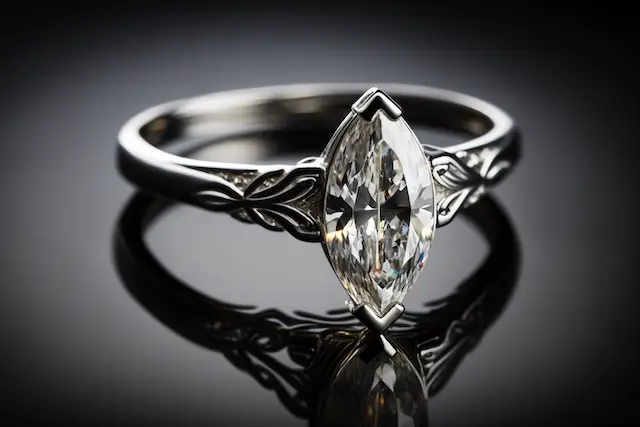
Sterling Silver: Pros and Cons
Pros
First off, let’s start with the advantages of choosing sterling silver as your metal for an engagement ring.
The most significant advantage is cost; unlike other metals such as platinum or gold, sterling silver is incredibly affordable, making it perfect for couples on a budget.
Additionally, sterling silver has a beautiful luster that won’t fade over time like other metals, meaning that your engagement ring will look as good as new even after years of wear and tear. Furthermore, sterling silver is hypoallergenic and can be easily resized if necessary.
- Inexpensive option.
- Bright and shiny appearance.
- It can be easily resized.
Cons
Despite its numerous advantages, there are some drawbacks when it comes to choosing sterling silver as your metal for an engagement ring.
One major disadvantage is that because it is so soft compared to other metals such as gold or platinum, sterling silver is more prone to scratches and dents, which may detract from its beauty over time.
Additionally, because it is so malleable, you may want to consider pairing your ring with another metal if you plan on wearing it frequently to give it greater durability and longevity.
Finally, because sterling silver doesn’t hold its value in the same way that other precious metals do (such as diamonds), you may not get back quite as much money should you decide to resell your ring in the future.
- Not as durable as other metals.
- Tarnishes over time.
- Doesn’t hold its value as well as other metals.
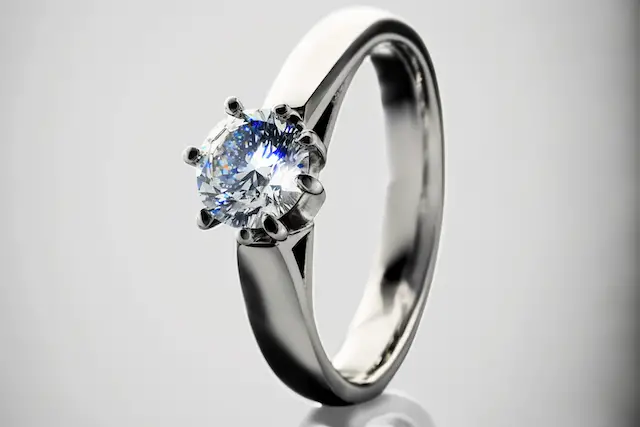
Cobalt Chrome: Pros and Cons
Pros
Cobalt chrome is quickly becoming a go-to option for many couples looking to customize their perfect engagement rings, and there are several reasons why.
First, cobalt chrome is incredibly hard and durable, so it won’t scratch or dent easily as some other metals might. It won’t corrode or tarnish either, so you don’t need to worry about it losing its luster over time.
Another benefit to choosing cobalt chrome is its natural white color that looks just like platinum or white gold without the hefty price tag associated with those precious metals.
In addition, this metal can be polished to create an even shinier finish if desired! Finally, cobalt chrome offers great value—it costs less than other metals like tungsten or titanium yet still provides incredible strength and durability.
- Very strong and scratch-resistant.
- Available in different colors.
- Affordable alternative to platinum or gold.
- Polishable for a shinier finish.
- Hypoallergenic and won’t corrode or tarnish.
Cons
While there are many advantages to using Cobalt Chrome as your engagement ring metal, some drawbacks should be considered before making your decision.
One major downside is that it can’t be resized like some other metals, such as gold or platinum, so make sure you get the size right! And while it’s highly resistant to scratches and wear and tear, it is not entirely scratch-proof—so it might require more frequent cleaning than some other metals.
Lastly, because it’s not as widely used as gold or platinum yet, finding jewelers who offer custom designs in Cobalt Chrome can be difficult (although this is changing rapidly).
- Not resizable if needed.
- Limited availability at traditional jewelry stores.
- Not completely scratch-proof.
Tungsten Carbide: Pros and Cons
Pros
One of the most significant advantages of choosing a Tungsten Carbide engagement ring is its durability.
This metal is one of the hardest substances on earth, making it highly resistant to scratches and dents. As a result, it has one of the highest scratch resistance ratings out of any other type of metal on the market today.
It’s also hypoallergenic, so if you have sensitive skin or are allergic to certain metals, this might be the perfect option!
The color of Tungsten Carbide is another advantage; this metal has a beautiful shine that won’t fade over time as some other metals can.
Special polishing techniques can also enhance the shine to make your ring look even more stunning.
Finally, because this metal is so strong and scratch-resistant, it requires very little maintenance over time; all you need to do to keep your ring looking great is occasionally clean it with a soft cloth!
- Very strong and scratch-resistant.
- An affordable option for those on a budget.
- Available in different colors.
- Hypoallergenic and won’t corrode or tarnish.
- Requires little maintenance over time
Cons
Because this metal is so hard, it cannot be resized after purchase – so make sure you get sized correctly before buying your engagement ring!
Additionally, if your ring gets damaged in any way (which is highly unlikely), then repairs can be difficult or impossible due to the hardness of the material.
Furthermore, though most rings are coated with an extra layer called rhodium plating which helps protect against tarnishing from exposure to air and moisture – removing this plating can damage the surface underneath and make your ring more vulnerable to wear over time.
Finally, because this metal is still relatively new on the market compared to gold or platinum rings, there may not yet be as many styles available – though more designs are constantly being released!
- Not resizable if needed.
- Difficult to engrave.
- Limited styles available.
- It can be damaged if rhodium plating is removed.
Zirconium: Pros and Cons
Pros
One of the greatest advantages of choosing Zirconium for your engagement ring is its durability.
Because it is so strong, it can withstand daily wear and tear without becoming damaged or losing its shine. It also has an attractive black finish, adding a modern touch to any ring design.
Additionally, because Zirconium is not as expensive as gold or platinum, couples who choose this metal can often save money on their rings while still getting a high-quality piece of jewelry.
- Strong and scratch-resistant like titanium or tungsten carbide but lighter weight than either.
- Attractive black finish.
- It can save money compared to gold or platinum.
- Hypoallergenic and won’t corrode or tarnish.
Cons
Even though it’s scratch resistant and durable, it can still be scratched by harder materials like diamonds or sapphires, which could be set into your ring design.
That being said, you would need to take extra care when wearing your ring to avoid scratching or damaging the surface over time.
Another potential issue with zirconia is that it is not widely available yet. Therefore, finding a jeweler who works with this particular metal may be difficult, depending on where you live or where you plan to buy your ring.
Additionally, because this metal is still relatively new on the market, prices may be higher than those associated with more traditional metals like gold or silver.
- Limited availability at traditional jewelry stores.
- Difficult to engrave due to the strength of the metal.
- Not resizable – so make sure you get sized correctly before buying your engagement ring!
Frequently Asked Questions
Which metal is best for a diamond ring?
Platinum is considered one of the best metals for a diamond ring because it is durable, hypoallergenic, and naturally white, meaning it won’t yellow over time like some other metals.
Additionally, platinum’s density and weight make it an ideal choice for securely holding a precious stone like a diamond. However, other metals such as gold or titanium can also be suitable depending on personal preference and budget.
What type of metal ring lasts the longest?
When it comes to longevity, platinum is considered the most durable metal for a ring. Platinum is naturally white, hypoallergenic, and resistant to tarnishing, making it an ideal choice for everyday wear. Additionally, platinum’s density and weight make it an excellent option for securely holding precious stones like diamonds.
While other metals like titanium or tungsten are also known for their strength and durability, platinum is often considered the top choice for those seeking a long-lasting ring.
What metal ring cannot be cut off?
Tungsten carbide rings cannot be cut off in emergency situations, such as when a finger swells due to injury. This is because tungsten carbide is an extremely hard and dense metal that can only be scratched with a diamond or other similarly hard materials.
While this hardness makes tungsten carbide rings very durable and scratch-resistant, it also means that they cannot be easily removed in emergency situations. For this reason, it’s essential to ensure that a tungsten carbide ring fits properly before wearing it regularly.
What metal is better for an engagement ring?
When it comes to engagement rings, several metals are commonly used, each with its unique properties and benefits. Here are some of the most popular options:
Platinum: Platinum is a popular choice for engagement ring settings due to its durability, hypoallergenic properties, and resistance to tarnishing. It is also a very dense metal, making it more secure to hold precious gemstones in place.
Gold: Gold is a classic choice for engagement rings and comes in a range of colors, including yellow, white, and rose. It is less expensive than platinum but durable enough to last a lifetime with proper care.
Palladium: Palladium is a relatively new metal in the jewelry industry that has gained popularity as an alternative to platinum or white gold. It is similar in appearance to platinum but at a lower cost.
Ultimately, the best metal for an engagement ring depends on personal preference, budget, and lifestyle factors such as daily wear and exposure to harsh chemicals or activities that could damage the ring.
